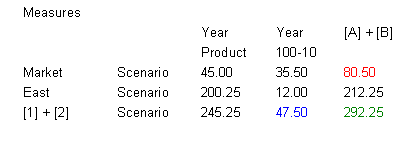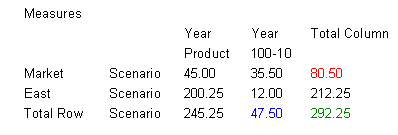Behavior of Annotations in Formula Cells
Right-click a formula cell in the report viewer to create an annotation.
The context of the annotation includes all dimensions except those that occur on the formula row and column. The content includes "Row X' and/or Column Y" instead of the dimensions that occur on the formula row and column ("Row 3", "Row 14", "Column C", "Column "AF"). For example:
-
If you annotate a cell with a value of 80.50, the context is: Measures/Market/Scenario/Column C.
-
If you annotate a cell with a value of 47.50, the context is: Measures/Year/100-10/Row 3.
-
If you annotate a cell with a value of 292.25, the context is: Measures/Row 3/Column C.
When displayed in the Annotation Panel, formula row and column headings are shown as the "display value" for the context rather than showing "Row X" or "Column Y". For example: 
-
If you annotate a cell with a value of 80.50, the context is: Measures, Market, Scenario, Total Column.
-
If you annotate a cell with a value of 47.50, the context is: Measures, Year, 100-10, Total Row
-
If you annotate a cell with a value of 292.25, the context is: Measures, Total Row, Total Column
Note:
The context of the annotation still uses "Row X" and "Column Y." It is just the annotation display value that shows the heading values. This is consistent with what happens with member names when the grid is displaying member aliases (the member alias is shown in the display value of the context).
Considerations:
-
You can include a formula row or column only in the context of an annotation by right-clicking on the cell.
-
You cannot navigate to a formula row or column through member selection from within the New Annotation dialog box.
-
The text "Row" and "Column" are in English and act like keywords. They are not localized.